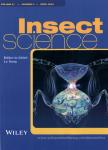Intraguild predation and competitive displacement between Nesidiocoris tenuis and Dicyphus maroccanus, two biological control agents in tomato pests
Intraguild predation and competitive displacement between Nesidiocoris tenuis and Dicyphus maroccanus, two biological control agents in tomato pests作者机构:Centro de Estudios Parasitol6gicos y de Vectores (CEPAVE -CCT La Plata- CONICET-UNLP) Boulevard 120 el 60 y 64 1900 La PlataArgentina Centro de Proteccion Vegetal y Biotecnologia Instituto Valenciano de Investigaciones Agrarias (IVlA) Unidad Asociada de Entomologia UJI-IVIA Carretera de Moncada - N&quera Km. 4.5 46113 Moncada Valencia Spain Unitat Associada d'Entomologia UJI-IVIA Departament de Ciencies Agr&ries i del Medi Natural Universitat Jaume I UJI Campus del Riu Sec E-12071 Castello de laPlana Spain
出 版 物:《Insect Science》 (昆虫科学(英文版))
年 卷 期:2017年第24卷第5期
页 面:809-817页
核心收录:
学科分类:0710[理学-生物学] 090403[农学-农药学(可授农学、理学学位)] 0830[工学-环境科学与工程(可授工学、理学、农学学位)] 07[理学] 09[农学] 070104[理学-应用数学] 0904[农学-植物保护] 0901[农学-作物学] 0701[理学-数学] 0713[理学-生态学]
基 金:funded by the Conselleria d’Agricultura, Pesca i Alimentacio de la Generalitat Valenciana, the Spanish Ministry of Science and Innovation the IRSES Project IPRABIO
主 题:competition Mediterranean crops Miridae temperature tomato
摘 要:Dicyphus maroccanus Wagner and Nesidiocoris tenuis Reuter (Hemiptera: Miridae) are 2 biological control agents in tomatoes. Through the crop seasons, a natural shift in the occurrence of both mirids in favor ofN. tenuis has been observed at the end of the cropping cycle in eastern Spain. To better optimize their conservation, the reasons for the observed change, such as intraguild interactions (IGP) or the influence of environmental conditions, are worth elucidating. To do this, we first studied the IGP of adult females on heterospecific nymphs in the laboratory. We next studied exploitative competition between adults and nymphs of each species when feeding on Ephestia kueniella Zeller (Lepidoptera: Pyralidae) eggs in the laboratory. Finally, to analyze the competitive displacement between both mirids, we conducted a semifield experiment in which both predators were released together. All experiments were conducted at 2 temperature regimes (20 and 25~C). Adult- to-nymph intraguild interactions occurred only at 25 ~C at very low levels, showing that N. tenuis attacked and consumed a greater proportion ofheterospecific nymphs. Nesidiocoris tenuis was a better competitor than D. maroccanus when feeding on the shared prey in the presence of its heterospecific nymph at 25 ~C. In semifield conditions, N. tenuis showed a competitive advantage over D. maroccanus at both temperatures. We conclude that there is not direct interference between both species, however, N. tenuis has a greater ability to outcompete, since it is best adapted to higher temperatures and it is able to remove food sources for D. maroccanus.



